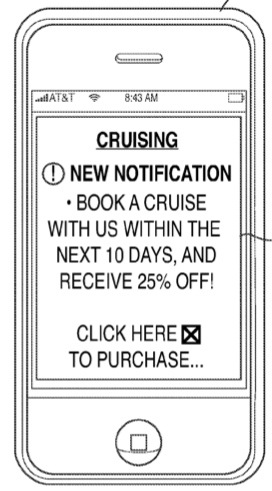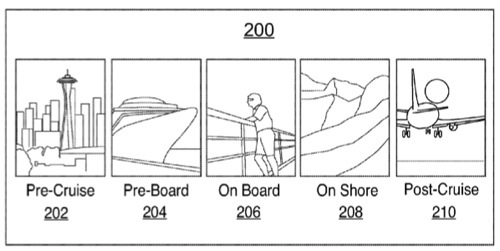Apple wants you to iCruise with your iOS device. A patent (number 20100306075) for systems and methods for accessing cruise services using a portable device has appeared at the US Patent & Trademark Office.
The patent is directed to systems and methods for accessing cruise services using a single, integrated application available to a portable electronic device. Through the integrated application, a user can access and control cruise services throughout all aspects of the cruise experience, including before booking a cruise, before boarding a cruise, while on the cruise ship, when a cruise ship is docked at a port, and after the cruise has finished.
In some embodiments, the integrated application can provide the user with notifications of available cruise activities. For example, unsold cruise activities for cruise activities that can be purchased can be identified. The user can then be provided with a notification of the unsold cruise activity, provided with an option to purchase the unsold cruise activity, or both. The inventors of the patent are Kaiann Drance and Stanley Carl Ng.
Here's Apple's background and summary of the invention: "Going on a cruise is an pastime enjoyed by many people. Cruises can allow one to go on a vacation that not only provides for the basic needs of its patrons (e.g., food, drinks, and housing), but also allows one to travel, explore new cities, take part in guided tours or "excursions" into these new cities, and treat oneself to onboard activities such as, for example, shows, casinos, spa appointments, and health club classes. In this way, going on a cruise is a unique experience that is different from, for example, other vacations or trips because it allows customers to take part in a wide variety of activities through one service provider.
"When a customer goes on a cruise, many interactions between the customer and the cruise service providers can take place. For example, a customer can interact with a cruise service provider to research the cruise line, to make a reservation, to obtain information related to onboard activities, excursions, or both, and to obtain post-cruise amenities. All of these interactions can require distinct actions from the user from different devices or elements. For example, a user can browse an on-line website to research a company, a user can call to make a reservation, a user may receive pamphlets listing onboard activities, excursions, or both under their door every morning of the cruise, and a user may sign up to receive follow-up promotions and coupons by e-mail after the cruise has ended.
"Although this combination of approaches for interacting with a cruise service provider can be serviceable, it remains cumbersome and requires the cruise service provider to accommodate all of the possible forms of interaction. From a user's perspective, the lack of centralization of interactions with the cruise service provider and with the available cruise services can require more effort from the user than desired, and perhaps even dissuade the user from going on a cruise or using available cruise services (thus at a cost to the cruise service provider).
"Systems and methods for providing an integrated interface for accessing cruise services using a portable electronic device are provided. The cruise services can include, for example, promotions and coupons associated with the cruise service provider, a listing of available cruise activities, maps of the cruise ship, a user interface for controlling entertainment systems and temperature within a user's cabin, a listing of safety and emergency information, providing notifications of and opportunities to purchase unsold cruise activities, and any other suitable cruise services.
"To access the cruise services, the electronic device can interface with the cruise system using any suitable approach. In some embodiments, the electronic device can securely connect to one or more servers associated with the cruise service provider. For example, the electronic device can connect with distinct servers associated with ordering services or goods from the cruise (e.g., room service). As another example, the electronic device can connect with distinct servers associated with attractions, shops, or stores for which the user can make reservations, purchases, or access information (e.g., for shops and attractions within the cruise ship or within a city at which the cruise ship docks).
"In some embodiments, a user can be provided with notifications of available cruise activities. In particular, in some embodiments a user can be provided with notifications of unsold cruise activities. For example, oftentimes a cruise may offer cruise activities that can be purchased, such as onshore excursions, tickets to shows, spa appointments, spots in fitness classes such as yoga classes, or any other purchasable cruise activity. When spots in such a cruise activity are unsold, notifications of the unsold activity can be provided to a user. The notification may include, for example, information related to the unsold cruise activity, an option to purchase the unsold cruise activity, or both. In some embodiments, targeted notifications can be provided by comparing attributes of an unsold cruise activity to a user profile of the user. In response the attributes of the unsold cruise activity matching the user profile, the user can be provided with a notification of the unsold cruise activity."
-- Dennis Sellers














